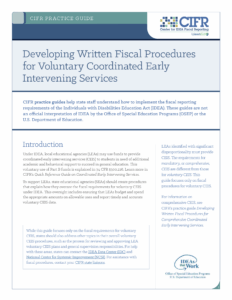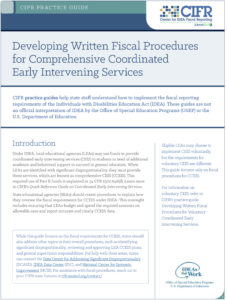This resource library makes it easy to find IDEA fiscal information within CIFR’s focus areas, including key resources for new state staff. Enter search terms or use the filters at left to narrow the list.

IDEA Part B Fiscal Timeline 1.5
This popular planning tool helps SEA staff manage and monitor the work they need to do to meet the fiscal requirements of IDEA.

IDEA Part C Fiscal Timeline 1.1
Lead agency staff can use this Excel tool to plan and track their yearly tasks to meet IDEA’s fiscal requirements on time.

From Data to Action: Using IDEA Fiscal Data
Use IDEA fiscal data to inform state technical assistance, policies, and practices with the questions in this online resource.

Using IDEA Part C Funds: How the First In, First Out Method Works
This guide explains the “first in, first out” method to help states use IDEA Part C funds before they expire.

IDEA Part B Maintenance of Effort (MOE) Reduction and Coordinated Early Intervening Services (CEIS) File Specifications
This document contains instructions for building files to submit IDEA Part B Maintenance of Effort (MOE) Reduction, Coordinated Early Intervening Services (CEIS), and Comprehensive CEIS (CCEIS) data.

IDEA Part C Maintenance of Effort Calculator
This Excel calculator helps lead agencies identify funding sources, track budgets and expenditures, account for allowances, and determine MOE compliance for up to five years.

Developing Written Fiscal Procedures for Voluntary Coordinated Early Intervening Services
This guide helps states create or improve procedures for managing IDEA Part B fiscal requirements for voluntary CEIS, providing sample language and guiding questions for key components.

Developing Written Fiscal Procedures for Comprehensive Coordinated Early Intervening Services
This guide helps states create or improve procedures for managing IDEA Part B fiscal requirements for comprehensive CEIS, providing sample language and guiding questions for key components.

IDEA Part B Maintenance of State Financial Support: The Basics
This video explains the IDEA requirement to maintain or increase state funding for special education and related services each year.

IDEA Part B State Set-Aside Calculator: Section 611
Plan state set-aside budgets, complete OSEP spreadsheets, and track expenditures using this Excel-based tool.

